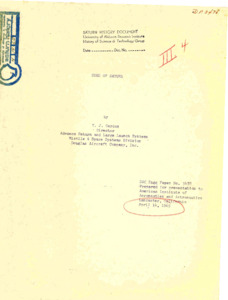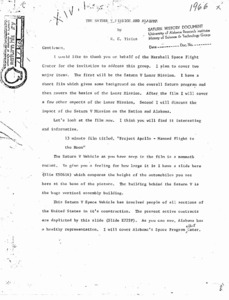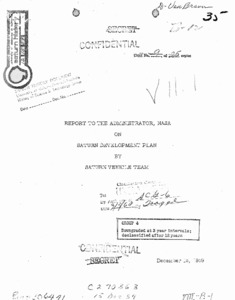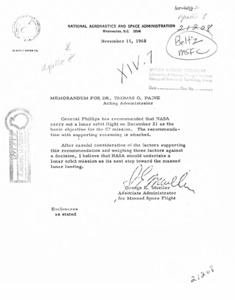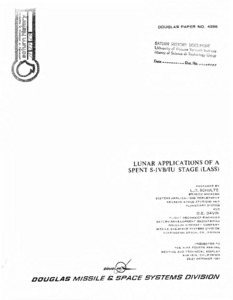
Browse Items (6 total)
Sort by:
-
"Uses of Saturn."
Saturn and Apollo hardware will not have realized their ultimate potential for space exploration after the project lunar landing is complete. To accomplish the Apollo lunar landing program, an immense backlog of technology, facilities, and booster capability will have been built up, and we believe proper utilization of this resource will fill the needs for planetary, lunar and earth orbital space exploration for years to come. -
"The Saturn V mission and Alabama."
Speech that covers the topics of the Saturn V lunar mission and the basics of a lunar mission in general. -
"Report to the administrator, NASA on the Saturn development plan."
In anticipation of this transfer, the NASA and Department of Defense have established, an interim working agreement that provides for immediate assumption by NASA of responsibilities fortechnical management of the Saturn vehicle development. -
"Memorandum to Associate Administrator for Manned Space Flight for Acting Director."
Poor photocopy. Memorandum discussing a planned lunar orbit mission and who is recommended for it. -
"Memorandum for Dr. Thomas O. Paine, Acting Director from George E. Mueller, Associate Administrator for Manned Space Flight, dated November 11, 1968."
Memorandum containing a recommendation from General Phillips to continue with the lunar orbit flight scheduled for December. -
"Lunar Applications of a Spent S-IVB/IU stage (LASS)."
Support of lunar exploration missions is a major consideration in future space program planning. The spent Saturn v/S-IVB/IU can support both lunar - orbit and lunar -landing operations. This paper investigates lunar applications of the spent stage, and incorporates data generated during Company-funded studies. Investigated here is the feasibility of using a launch vehicle employing standard S-IC and S-I1 boost stages to deliver a modified S-IVB/IU and large discretionary payloads to a lunar orbit (LASSO) and/or the lunar surface (LASS). Operations in Earth orbit and direct-ascent trajectories are examined, and consideration is given to the use of the spent stage as a shelter in a manner similar to the presently planned Earth orbital workshop operations. Both the LASSO and LASS concepts are recommended for consideration in future lunar exploration plans. These concepts are capable of placing a gross wet weight of 101,400 lb in lunar orbit or landing 63,580 lb on the lunar surface respectively. The effective payload capability can be enhanced by proper integration of translunar mission subsystems with the subsystems required for lunar orbit or surface operations. The vehicles can be available within 3 years, with current-technology hardware sufficient for performing the missions described.; Douglas Paper No. 4256.
